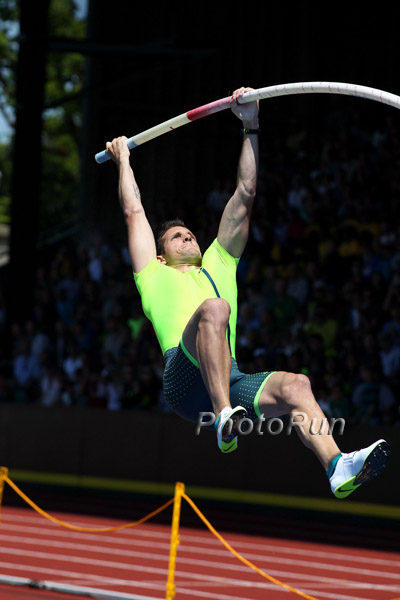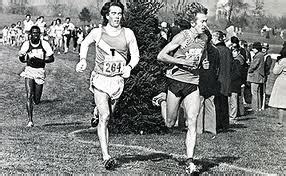
Renaud Lavillenie, photo by PhotoRun.net
The press day or “Presser” as it is called by my European comrades. The Press day consists of 15-20 fifteen minute interviews, divided into four an hour, with about an hour’s break. It is the media world’s way of doing interval workouts. A bit longer than the old 20 times 400 meters that I did on Tuesday for a decade or so, but a great way to get caught up with my favorite athletes.
This year, I interviewed Brittney Reese, David Oliver, Pascal Martinot Lagarde, Renaud Lavillenie, among others. I have to honestly say, there is not a current athlete on the circuit who is really a pain in the gluteus maximus. There were. At one time, in the 80s and 90s, some managers thought that, to get real money, that their athletes had to be completely and absolutely unavailable to the press. When IMG got involved in road racing, they had previously thoughtful athletes show up 90 minutes late for interviews. This does not go over with media types who had deadlines. And then, managers and athletes were shocked about the poor coverage that they received.
The way we covered track and field was changed forever in 1995 when Keith Peters, then, Nike PR deity, developed a series of bios on the web for athletes and had Steve Miller doing daily interviews in Goteborg, Sweden for the World Outdoors. The ploy by Peters was brilliant. The company with the most athletes, in a battle with then Reebok and adidas, went out of its way to make media happy, with meals, interviews, an easy place to get to and access to some of the greats. It was then that I met Venuste Nyongabo, who would win the 5,000 meters gold in Atlanta (now Nike manager of sports for Italy).
Keith Peters was pretty savvy about the need for content for media and had Marc Bloom, I believe, working on much of the content. This continued through the 2000 Summer Olympics. After Keith Peters left, the powers that be at Nike forgot how providing access to athletes, product and stories gave Nike much better stories in the end. While they had some strong PR people, no brand stepped up and provided content that was open and of true value to media.
Dave Mingey took over from Peters at Nike, and did a tremendous job from 1996 to 2000. Mingey got it, and realized that if you told an untruth to the media, you had one time to do it, so do it well. Mingey was a relationship guy, and his assistance and his integrity, to this day, stand out. After Mingey and Peters left Nike, Nike went back to public relations focus. The idea with PR, many times, is not to provide content and access, but to manage the damage. It is, in many ways a self fulfilling prophecy.
Sometimes the simple lessons are lost. Since 2000, there would be brands that shine out. Reebok did a great job in 2004 (and 2005 and 2007), and in 2008 and 2012, it was adidas that shone above all. Media want access to athletes, and those opportunities are much appreciated.
Reebok did a media site in Osaka that was even more accesible than Helsinki, and they were not even sponsors. They did the same in 2003 in Paris (Eiffel Tower). Giving us access to athletes, content, food, kept media satiated, and in constant contact.
What AREVA gets, and that is one of the reasons why I come here, is that, for the seats to be filled, we need more than stories about Usain Bolt. Renaud Lavillenie, Brittney Reese, Will Claye, Sanya Richards-Ross, Pascal Martinot Lagarde, and of course, Galen Rupp, Mo Farah, and great races by the likes of Molly Huddle and Shannon Rowbury get ink because they are fine stories.
The Diamond League is getting that. We are provided bio sheets, heat sheets online and in print, as well as good viewing of the meet. The Pre meet, for years, did a great day of interviews (and still does) with Tom Jordan doing a few questions before hand. adidas Grand Prix does a nice day with some great panels. This year, Bohdan Bondarenko, Mutaz Barshim and Erik Kynard were amazing!
It is one of the reasons why all footwear brands just fuse into one. And many other brands do the same. If you just present yourself in one format, be it print, social or digital, you are a commodity. Tell the story, tell it well and tell it in the culture (social media, digital media, mobile media, print media) well.
It is not new lessons, it is using the new technologies to reinforce relationships. At the recent USA champs, I saw, happily, an entire new generation of media professionals, encamped in the media tent, in hot and humid conditions, writing to their readers about the sport that they love.
Over the past three to four years, the results of the IAAF reinventing how they manage media has come to light. The website, IAAF.org, Spikesmag, social media, has all given the sport constant content and stories. Under Nick Davies and Chris Turner, IAAF’s team provides writers like myself with strong content, and access to the key players in our sport. The IAAF, it seems, was as alarmed as many of us, in the lack of coverage that athletics was getting across the world. As media world changes, the business offices get more say when revenues drop. Unless you bring in sponsors, or find ways to cut costs on coverage, coverage goes away.
The challenges for the sport to gain more coverage and for the sport to grow increase every day. Relying on one super star, Mr. Bolt, is not the way for the sport to grow. That Usain Bolt is so loved and worshipped by young fans is not his fault, it shows that charismatic, relaxed, athletes whose stories are told, can create followings.
For our sport to survive, we need many more heroes!
Want to grow the sport? Media matters. Print, social, digital, the combination of them work. MIT and the German newspaper league did a recent study. The households with the most money read, don’t be shocked, mobile, social, ipads and oh, my gosh, PRINT! When such types see media in multiple formats, it REINFORCES the value.
And for god’s sake, re read Marshall McLuhan’s Gutenberg Galaxy. The medium is the message!
Larry Eder has had a 52-year involvement in the sport of athletics. Larry has experienced the sport as an athlete, coach, magazine publisher, and now, journalist and blogger. His first article, on Don Bowden, America's first sub-4 minute miler, was published in RW in 1983. Larry has published several magazines on athletics, from American Athletics to the U.S. version of Spikes magazine. He currently manages the content and marketing development of the RunningNetwork, The Shoe Addicts, and RunBlogRun. Of RunBlogRun, his daily pilgrimage with the sport, Larry says: "I have to admit, I love traveling to far away meets, writing about the sport I love, and the athletes I respect, for my readers at runblogrun.com, the most of anything I have ever done, except, maybe running itself." Also does some updates for BBC Sports at key events, which he truly enjoys. Theme song: Greg Allman, " I'm no Angel."
View all posts






















